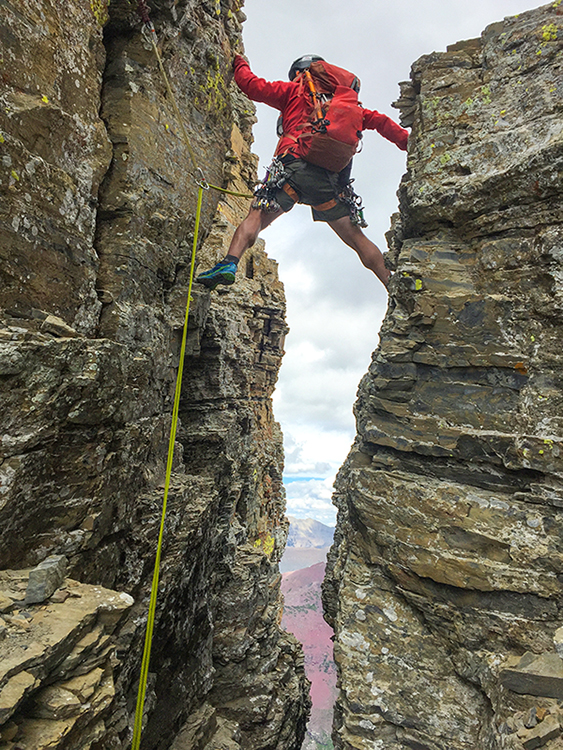Approach / Technical Climbing
Approach shoes for climbing are typically stiffer, more sticky, and more durable than shoes designed for trail running. This holds true for the Wings Pro 2, but they aren’t incapable. I led some 5.6 crack climbing, did some foot jams, and led a pitch of 5.5-5.6 choss chimney to see how they did.They don’t have sticky rubber, and once broken in, the soles are medium stiff at best. Yet, with good technique, they did just fine.

I did feel like I could trust my feet, which came in handy with all the fourth class scrambling I did. Can you climb lower class 5th in the Wings Pro 2? Sure. And if stickier rubber is a big deal for you, the S-Lab Wings delivers a grippier sole in what is mostly the same shoe.
Mixed Mountain Days
Most bigger days in Glacier mix together a whole pile of attributes. In July, my friend Jill and I went off to check on the existence of a high route via goat trail in Glacier National Park. We did nearly six miles by trail, then veered off into slanting scree, talus, and ledges while navigating below cliffs high above the Going to the Sun Highway. At one point, the goat trail ended in wet slabs, which we downclimbed into a bergschrund.
Chimneying across that fissure, half snow half rock, through a little squeeze tunnel coated in mud, we made it through onto the goat trail on the other side. The trail continued along exposed cliffs to a saddle, and we did some 4th class moves up a ridge to a summit. We then retraced part of our route, dropped to a trail, and walked seven miles out.
Such details are the things that seem to happen on my Glacier days. My feet edge while climbing, glissade, walk trail, slide through screen, and grip on dust. The Wings Pro 2s kept up marvelously on these sorts of days, and I never felt like I was completely undergunned. The Wings Pro 2 proves that blends of attributes do the best.
Comparison with S-Lab Wings
At this year’s Rut race, I took advantage of the Salomon demos to try out the S-Lab Wings for the sake of comparison in the same size, but in a more shocking red color.
In the S-Lab Wings, the result of all the stripping down they do to make a race worthy shoe is that they genuinely feel lighter on your feet (The S-Lab Wings 8 comes at the claimed 275 g, fully 60 g lighter than the Wings Pro 2). The sole is also stickier, which I enjoyed while doing a bit of scrambling on the choss of Lone Peak.
The S-Lab Wings does feel a bit less built out than the Wings Pro 2, meaning I’d be less inclined to pick it for the rough, off-trail readiness that I want in my shoes. I’m also a little leary of the lace system lacking plastic brackets, as I’ve seen the kevlar saw through the loops before after a bunch of use.
Durability
The weakest aspect of using a trail running shoe for things it wasn’t intended to do is that they will fall apart sooner than you’d wish. Mine currently sport a few rips in the mesh of the main shoe, small holes in the heel cup mesh, one of the toe caps is peeling, and the soles are somewhat worn from all the scree and talus play. Nothing out of the ordinary for running shoes in the mountain environment. The price of going light and breathable, in this case, is durability.
That said, I’d bet that I’m only halfway through the life cycle of my Wings Pro 2s. Other Salomons have looked just as bad and done me a ton more service. If I can get 400 miles out of them, that seems plenty by running shoe standards.
Bottom Line
If you’re looking for a do-it-all trail running shoe that stretches the boundaries of running, scrambling, and low 5th climbing, you’ll find a good foot partner in the Salomon Wings Pro 2. It lacks the durability or specific benefits offered by more narrowly focused footwear choices, so be aware that you’re making a series of compromises to achieve a better blend of attributes.
